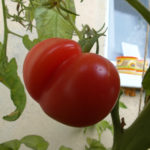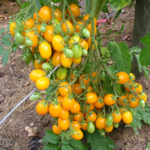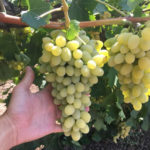Rose Sangria
Perhaps we will not twist our hearts if we say that the rose garden is the dream of any florist. The area where roses are grown can be large. Then various plants can act as companions of the queen of flowers. The rose looks especially noble against the background of conifers; you can even embed various light architectural structures into the composition. But even in a small summer cottage, you can create a unique corner to the envy of others. It will not be difficult for an experienced gardener to plan a future rose garden and select varieties for it. But a beginner may experience certain difficulties, because you need not only to correctly compose the composition according to color, flowering time and determine the size, but also to be able to properly care for the main character of your dreams. For those who have just started to master the basics of growing roses, the best choice is unpretentious varieties. But this does not mean that their appearance will be modest or boring. On the contrary, there are a lot of bright beauties among the easy-care royal creatures. Floribunda Sangria is a very good example.
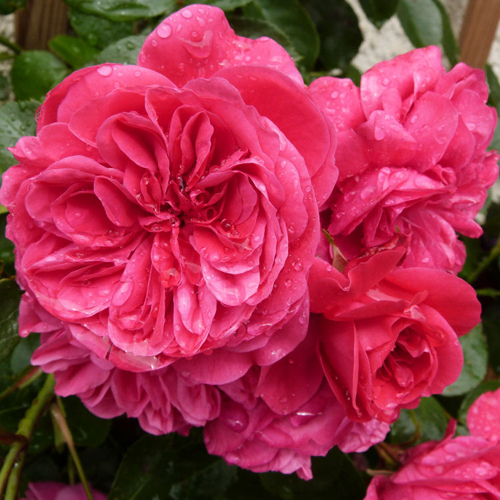
History of creation
Sangria is relatively new. She belongs to the French selection. The company that announced it in 2000 is well known to all lovers of the queen of flowers - this is Meilland International. The registration name of our heroine is MELprille. Its rich color fills with energy, gives cheerfulness and positive. And the passionate Frenchwoman got her name for a reason, because she, like the light Spanish drink Sangria, is capable of turning your head. The variety has another name - Sonja Meilove.
Description
Plants are very strong, do not need support, low, 80 - 90 cm high (although in unfavorable conditions, growth is limited to 50 - 60 cm). Rose bushes are branchy, spreading - up to 80 cm wide, well leafy, have lush rounded outlines. Thanks to this, the perennial turns out to be, as it were, multi-tiered, completely covered with foliage and inflorescences. Rose growers note that the plant is very harmonious and easy to care for, as it never forms long, ugly fishing rods. The leaves are dark green, large, shiny, leathery to the touch, very decorative. The upright shoots are crowned with chic inflorescences, consisting of 5 - 10 flowers.
The flower rosettes collected in lush and dense inflorescences are not very large - the size is about 6 - 8 cm. The flower shape of Sangria is very interesting - rosette, two-tiered. In the process of dissolving, the petals are very strongly bent back, giving the rose the appearance of a fluffy pom-pom. The flower attracts with its dense doubleness, it consists of more than 100 petals. In the lower tier, the petals are large, with rounded and even edges; in the upper tier, they are slightly smaller in size, with a slightly pointed apex. The color of the petals is bright, deep crimson, reminiscent of fuchsia.
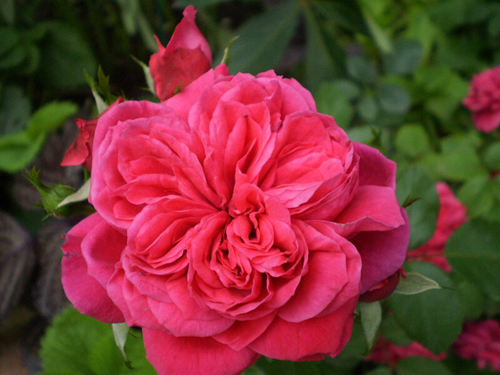
Bloom
Sangria pleases with continuous and abundant flowering, during which the rose bush resembles a huge multi-flowered bouquet, which is harmoniously complemented by luxurious green foliage. Many flower growers call their favorite a real hard worker, because the flower extravaganza lasts without a break until the onset of cold weather. And the buds bloom about half a month earlier than other floribundas. But such an abundance of flowers obliges the gardener to keep the bush in a tidy condition. If the faded heads are not removed in time, the French woman can easily lose the decorative effect. In the process of wilting, the catchy acid color of the petals changes to a calmer one, shades from light purple to pale pink will already prevail. A cosmetic haircut will promote the rapid growth of new buds. The inflorescences last quite a long time, especially if the sun periodically hides behind light clouds. In the heat, flowering will be fleeting, the rosette opens very quickly and lasts only 3 to 4 days. If you expect an intense scent from a bright beauty, you will be a little disappointed. Our heroine is deprived of a strong aroma, it is very weak.Although some rose growers argue that this is not the case, the scent is felt at a short distance.
Characteristics
- With flowering, and quite lush, the rose will delight the next season after the autumn planting. It can bloom even immediately after planting in spring. But Sangria will come into real strength when it finally forms a bush, and this will happen very soon, in just a couple of years;
- Sangria is excellent for the climatic conditions of central Russia, especially praised by the gardeners of the Moscow region, where weather conditions allow the decorative qualities of the flower to be fully manifested. Winter hardiness according to USDA (the system adopted by the US Department of Agriculture) corresponds to zone 6, so the plant can tolerate temperature drops in winter to -23.3 ° C without shelter;
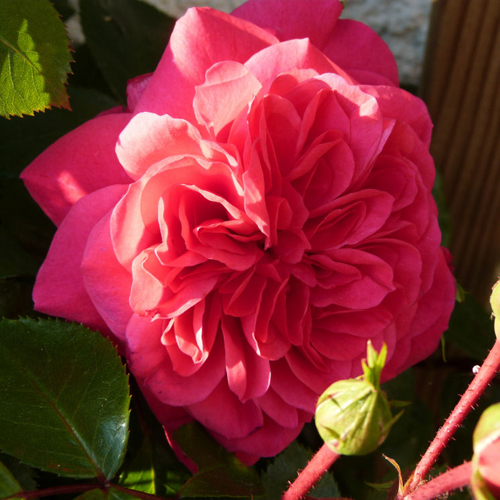
- originators describe immunity as average. In general, the plant is resistant to diseases, but in unfavorable years it can be affected by black spot or powdery mildew. The same happens with weakened seedlings, for which practically no maintenance is carried out. But many growers still insist that the variety is able to resist disease, as evidenced by numerous photographs of the rose, where healthy foliage acts as a background for magnificent lush inflorescences;
- moisture resistance above average. During the period of prolonged rains, the densely doubled flower becomes heavy, due to which the shoots can wilt. In addition, individual flowers that are close to fading lose their presentable appearance faster. But overall, Sangria is rain resistant.
Planting and leaving
Sangria is quite unpretentious and non-capricious, but at the same time spectacular, bright. You can plant a perennial in autumn and spring. Experienced flower growers insist on an autumn planting, which, in their opinion, is more suitable for our heroine. In central Russia, the most comfortable place will be in a sunny area. True, with a shortage of illuminated places, the rose will grow beautifully in diffused penumbra. By the way, it is in such conditions, according to the observations of rose growers, that the color of the French woman becomes even more intense. But in the southern regions, the hot sun will play against the decorative effect of the rose, therefore, initially the planting should be planned so that in the midday period the flower is covered by a light shadow from the burning rays. Watering is carried out moderately, as needed, so that the soil does not dry out. To maintain abundant flowering, it is necessary to introduce nutrient mixtures on time. During this period, the flower will be grateful for the universal fertilizer for flowering. Pruning is carried out in the spring, old and growing shoots inside the bush are removed. You can form a flowering bush on a low trunk, this will add additional decorativeness to the perennial.
Sangria is, according to numerous reviews, an unpretentious variety. A bright, perky rose is distinguished by good winter hardiness, has good immunity, and is resistant to rain. Our heroine stands out favorably with abundant flowering, which begins early enough and ends, according to reviews, with snow. Floribunda can be planted not only in a rose garden or in a flower bed. A short plant can be used to create a decorative border or against the backdrop of a short-cut green lawn. It can even be used as a vibrant ground cover. But there are difficulties with the selection of neighbors. Not every variety of roses or other types of plants can be combined with such a cheerful color. Also, certain problems will arise due to the large number of crumbling petals. They should be removed from under the bush in time. For lovers of calm pastel shades, the bright color of Sangria may not suit.
